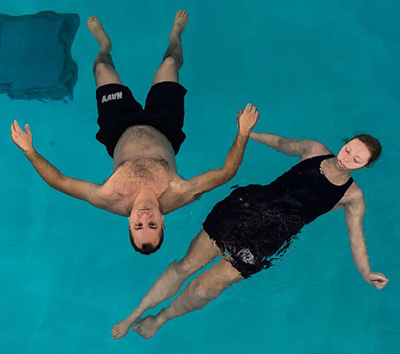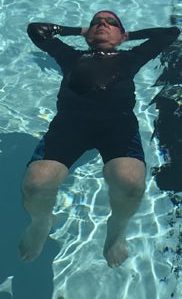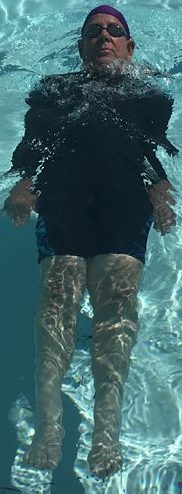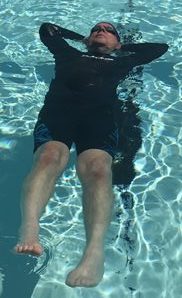Many of my swim and lifeguard students insist to me that they can’t float. They have been told by friends, parents, even swim instructors that since they do not float horizontally, they are not floating properly.
What they have been convinced of IS COMPLETELY WRONG.
-If you put an inflated beachball in a swimming pool it will float on the surface of the pool.
-If you toss a rock in, it will sink quickly to the bottom of a swimming pool.
-Human beings have a density somewhere between a rock and a beachball, and everyone can float.
When we are floating (lying on our back or front in the water, not moving our arms or legs),
some people float in a horizontal position with their entire body, including their legs, up at the surface,
some float diagonally, with their legs lower in the pool water,
some float almost vertically (in shallow water their toes might be touching the bottom / floor of the pool).
All these positions for floating are correct.
Here is a photo from a United States Navy Officer Development School third-class swimmer test,
of a man floating a little vertically and a woman floating more horizontally.

Parts of our bodies are denser than the water, parts are lighter.
Muscle and bones are denser / heavier than the water. Athletes have more muscle and often denser bones, so they commonly float more diagonally or even vertically. (This includes people who do not think of themselves as athletes, but just as people who walk / jog / run / dance or play soccer, rugby, tennis, etc. a lot.)
Body fat and a big breath of air in your lungs is lighter (less dense) than the water. Since most women have more body fat than men, they float more horizontally.
Most children float more horizontally because they do not have as much muscle mass and their bones are less dense.
Since our torsos have air in them and our legs have no air, it is our legs that do any sinking when we are floating and our torsos stay closer to or at the surface of the water.
Each of my swim classes usually tries an experiment with floating and discusses why some people float horizontally, some diagonally, and some vertically.
For everyone, their center of mass (the center of the cubic inches of you) is about in the center of your waist or hips. Your center of buoyancy (the center of all the parts of you that are lighter than the water and make you float, including the air in your lungs) can be in the center of your chest or your abdomen. If they are near each other you will float horizontally and if they are not, for example if you have little body fat but lots of leg muscle, you will float diagonally or even vertically.
Below a man floating with his arms at his sides and with his heels almost on the bottom / floor of the pool in the shallow water.
He is not doing anything wrong with his floating.
His center of buoyancy is in his chest and his center of mass is closer to his legs.
As an experiment with the laws of physics,
he can adjust his center of mass in relation to his center of buoyancy and float more horizontally.
Our swimmer can start by floating without moving, to see if, or how far, his legs sink (as in the photo above).
He can start to adjust his center of mass in relation to his center of buoyancy by moving his hands / arms from along his sides to behind his head:
Then he can bend both legs completely and take in as big of a breath as possible to become as horizontal as possible.

(A swim student who did this during one of our classes
wrote it up in detail for his physics class and impressed the instructor.)
![]()
Lifejackets give you even more buoyancy; many can keep your head out of the water in an emergency.
Why you should wear a lifejacket has tips for fitting them.

Every swim class at De Anza College includes curriculum
(the subjects that are supposed to be taught in the class)
about hydrodynamics listed below:
“A. Experiment with the laws of physics as they apply to basic (or beginning, intermediate or advanced) swim skills.
1. Archimedes’ principle – the human body in relation to water density
2. Buoyancy, specific gravity, and displacement
a. Fat versus muscle in determining flotation capability
b. Male vs. female
c. Center of mass vs. center of buoyancy and equilibrium
d. Supine floating versus prone floating
3. Drag and resistance – form drag, wave drag, and frictional drag
4. Efficient versus inefficient body movement while in water – streamlining the body
5. Bernoulli’s theorem and laminar flow – lift
6. Conservation of momentum, laws of inertia, acceleration, action and reaction, and levers”
We review the above mostly by applying the theories to swim skills,
thinking about why, for example, when people swim underwater with straight arm pulls it is not as effective as with a bent arm pull.
Rather than taking time to cover all of it during class time (and certainly not trying in the pool all the experiments / activities in the text linked to below), you can feel free to read more than what is at this webpage.
The American Red Cross Swimming and Water Safety Manual public libraries number is 797. This is the text for the Red Cross swimming teacher certification Water Safety Instructor.
It might be still downloadable for free. Go to
https://www.redcrosslearningcenter.org/s/candidate-water-safety
scroll down to Participant Materials and click on and open Swimming and Water Safety Manual.
Pages 78 to 85 are the chapter on Hydrodynamics, with details about the laws of physics and swimming in the De Anza college swim class curriculum.
There is not any written homework for this reading.
Info for adult non-swimmers (or people who can swim a little, but are not comfortable in water that is deeper than they are tall):
KNES 001A (formerly P.E. 26A) is the Novice swimming class at De Anza.
For info about the class click on these links:
If you are not sure whether this is the right class for you, read a description of typical students and goals of the class at: Novice swimming
Novice Swim FAQs has the cost, etc.
If you think you can’t learn to swim, read Letters from novice students
——————————————————————-
The author of this webpage, (written as a reading assignment for my students), does not give any warranty, expressed or implied, nor assume any legal liability or responsibility for the accuracy, completeness, or usefulness of any information, product, or process included in this website or at websites linked to or from it. Users of information from this website assume all liability arising from such use.



